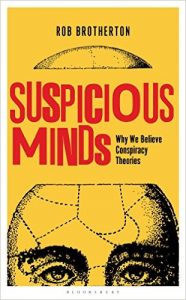 Australia’s national radio broadcaster, Radio National (RN), aired an interview with Rob Brotherton, Visiting Research Fellow at Goldsmiths, University of London, trying to explain to us why conspiracies are generally “all in the mind“. Obviously Brotherton and RN are controlled by the Illuminati and are being used to convince a gullible public that a secret cabal is not manipulating the world economy, the world’s governments, the events in the Middle East and major terrorist attacks in the West.
Australia’s national radio broadcaster, Radio National (RN), aired an interview with Rob Brotherton, Visiting Research Fellow at Goldsmiths, University of London, trying to explain to us why conspiracies are generally “all in the mind“. Obviously Brotherton and RN are controlled by the Illuminati and are being used to convince a gullible public that a secret cabal is not manipulating the world economy, the world’s governments, the events in the Middle East and major terrorist attacks in the West.
Sucker that I am I raced out and grabbed a copy of Brotherton’s book, Suspicious minds : why we believe conspiracy theories. I began serious reading at chapter 3, What Is a Conspiracy Theory? Early on I came across this interesting passage:
There’s no denying that the label has less-than-favorable connotations in some intellectual circles, at least. “If you’re down at a bar in the slums, and you say something that people don’t like, they’ll punch you or shriek four-letter words,” Noam Chomsky once said. “If you’re in a faculty club or an editorial office, where you’re more polite— there’s a collection of phrases that can be used which are the intellectual equivalent of four-letter words and tantrums. One of them is ‘conspiracy theory.’”
Brotherton, Rob (2015-11-19). Suspicious Minds: Why We Believe Conspiracy Theories (Kindle Locations 931-935). Bloomsbury Publishing. Kindle Edition.
Ah, so that’s why a handful of scholars sometimes toss out “conspiracy theory” at arguments they appear not to have seriously investigated and that for all the world seem to me to have nothing to do with “conspiracy theories” at all.
I just want to isolate and share one thought from chapter 3 in this post. Brotherton rightly points out that defining what we mean by conspiracy theory is problematic given that at some point “one person’s conspiracy theory is the next person’s conspiracy fact. . . . ” so “blithely asserting that conspiracy theories are bullshit doesn’t get us very far.” Instead, Brotherton speaks of a conspiratorial style:
Richard Hofstadter, an influential scholar of conspiracism, talked about conspiracy theories as a “style” of explanation. Much as a historian of art might speak of the motifs that collectively constitute the baroque style, or a music critic might parse the subtle differences between dubstep and grime, our task in distinguishing conspiracy theories from regular old theories about conspiracies is to identify some of the most important rhetorical themes, tropes, and flourishes that collectively constitute the conspiracist style.
Brotherton, Rob (2015-11-19). Suspicious Minds: Why We Believe Conspiracy Theories (Kindle Locations 925-929). Bloomsbury Publishing. Kindle Edition.
Not that these style-points are foolproof rules, either. Think of them more as indicative guides, Brotherton says.
So we’ve laid out six crucial elements of the conspiracist style. Before we take stock and move on, however, a note of caution is required. Coming up with a checklist can give a false impression of objectivity . . . .
Think of our six characteristics as useful rules of thumb, rather than immutable laws. . . .
It’s worth reiterating that none of the features we’ve talked about, in and of themselves, distinguish conspiracy fact from conspiracy fiction. Just because a claim meets our six criteria doesn’t mean it can’t be true.
Brotherton, Rob (2015-11-19). Suspicious Minds: Why We Believe Conspiracy Theories (Kindle Locations 1198-1215). Bloomsbury Publishing. Kindle Edition.
So what are those “six crucial elements”? Continue reading “The Conspiracist Style”
